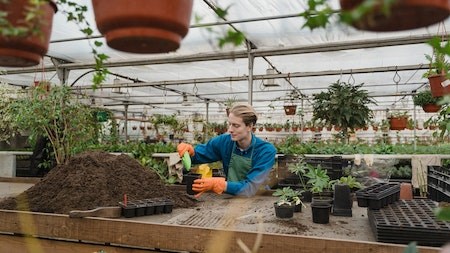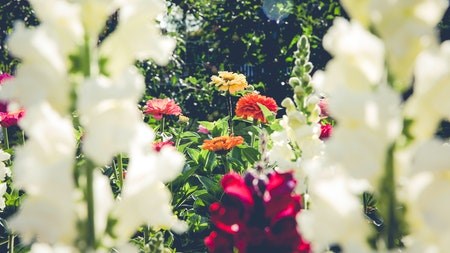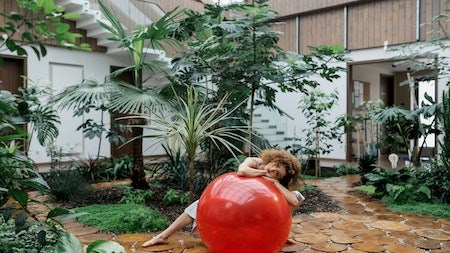Companion planting is the practice of positioning two or more types of plants, both beneficial to each other, close together as each chemically enhances - or inhibits - the other’s growth and increases the production of fruit and flowers.
Companion planting also increases biodiversity in the environment and has many advantages in gardening as well as organic farming. These include improved soil quality, resulting in more nutrients being available to plants.
In the garden, companion plants can be used to provide attractive habitats or food for favourable insects, like spiders and ladybirds that help control destructive pests. Herbs like basil, borage, dill, sage and thyme all attract beneficial pollinating insects.
The process
In farming, the method is known as intercropping; sometimes, just a few plants are interspersed among an entire crop. For example, a few cabbages could be planted between rows of pumpkins. The cabbages attract aphids, which will then ignore the pumpkins.
Another example is when maize, runner beans and pumpkin are intercropped, with each plant providing support for the others. Beans supply nitrogen to the soil, and maize plants act as structural supports for the bean runners and protect pumpkins against squash vine borers. Pumpkin plants will cover the soil surface – much like a groundcover - and limit weed growth.
Some plants may suppress others or be detrimental to their growth. For example, beans make poor companions for onions and fennel, and cabbage and tomatoes should not be planted together.
Companion planting is often practised in the garden to control insects, and there are many ways in which you can combine plants to benefit each other.
Some plants - such as rosemary and African wormwood (Artemisia afra) - are natural insect repellents. Other plants such as carrots, fennel and yarrow attract beneficial insects such as ladybirds and hoverflies.
Scent
Many companion plants produce scents that confuse and deter pests or may mask or hide a crop from pests. For example:
- Many companion plants produce scents that confuse and deter pests or may mask or hide a crop from pests. For example:
- Interplanting marigolds with row of cabbages means they suffer far less insect damage than when planted alone.
- Annual herbs like anise, coriander and mustard act as protective herbs when you interplant them between rows of vegetables.
- The pungent scents of parsley, garlic and marigolds are said to help keep pests away from roses.
- Garlic, chives, marigolds, mint and coriander are all known to repel aphids.
- Radishes and nasturtiums draw beetles away from other plants.
According to The Gardener, plants with intensely aromatic leaves generally repel insects and can be interplanted with vegetables or flowers.
These include feverfew, elder, lavender, mugwort, nasturtium, pyrethrum, rue, Santolina, winter savoury, and garlic.
There are other plants that release chemicals from their roots that suppress or repel pests and protect neighbouring plants. For example, marigolds release thiophene, a nematode repellent.
Still, other plants provide beneficial habitats for predators such as ladybirds, mantids and spiders, which help keep pest populations in check.
The intensely aromatic foliage of these herbs deters pests or masks the odour of other plants that are sought after by pests:
- Pennyroyal or Mentha pulegium is known for repelling ants and can be planted around wormeries to keep them ant-free. It grows in full sun or shade, and the leaves release a strong peppermint fragrance when crushed.
- Tansy or Tanacetum vulgare is a very effective insect repellent. A perennial plant, it grows 1.2 m high and is 1 m wide, with fern-like foliage and clusters of yellow button flowers. It requires good drainage and room to spread.
- Feverfew or Tanacetum parthenium is a medium-high (60 cm) annual plant with strong-smelling and bitter-tasting foliage that repels any insect that comes into contact with it. The white daisy-like flowers attract butterflies and bees. It’s an attractive garden flower.
- Chives or Allium schoenoprasum keep aphids away from roses, grapes, tomatoes, carrots and fruit trees.
Good companions
Many herbs make excellent companion plants. For example, chamomile, lovage, marjoram, parsley, amaranth, pennyroyal, oats and legumes like beans and peas all enhance the growth of nearby plants.
- Nasturtiums improve the flavour of most vegetables.
- Basil is a good companion for tomatoes, cucumber, lettuce and spinach.
- Celery benefits leeks, tomatoes and beans.
- Chives are good for carrots, parsley, apples, melon, beans, cucumbers, beetroot, lettuce and gooseberries.
- Flax improves the flavour and size of carrots and potatoes.
- Plant dill close to lettuce, mealies, cucumber, carrots and tomatoes.
- Annual morning glory stimulates melons, beans and grapes.
- Chervil goes well with radishes and carrots.
- Mint improves cabbages and peas.
- Borage sweetens strawberries and tomatoes.
- Caraway is good for peas.
Bad companions
You also need to be aware that there are some plants that harm each other when planted together.
For example:
- Don’t plant brassicas like broccoli or cauliflower near strawberries, beans or tomatoes.
- Keep carrots away from potatoes, fennel and cabbages.
- Fennel is harmful to tomatoes, beans, dill, caraway and coriander.
- Don’t mix strawberries and garlic or mint and parsley.
Let your garden area flourish by properly implementing companion planting.
Writer : Sarah-Jane Meyer




